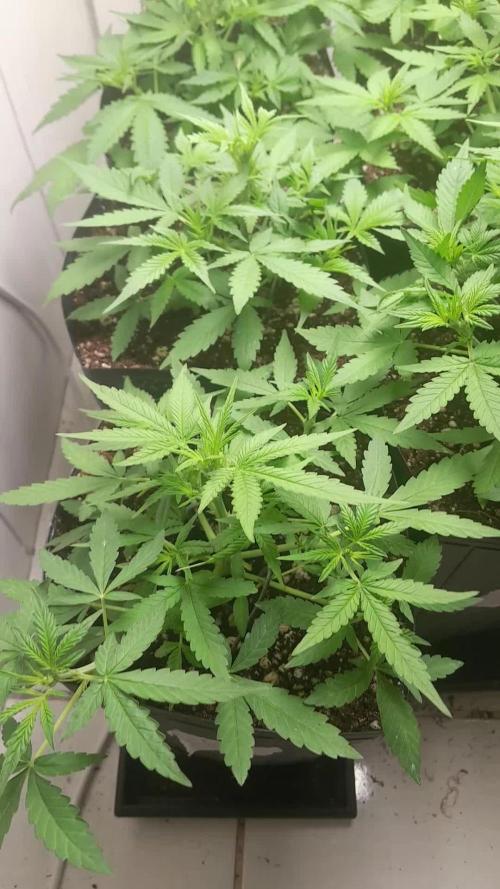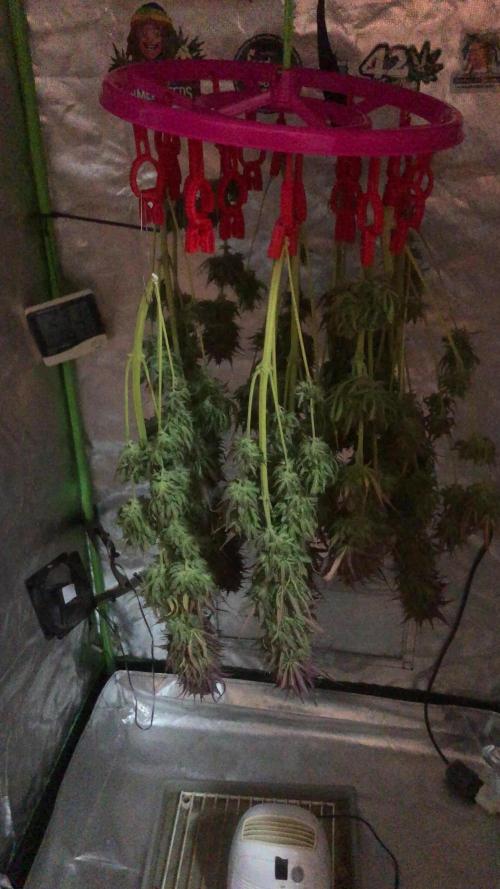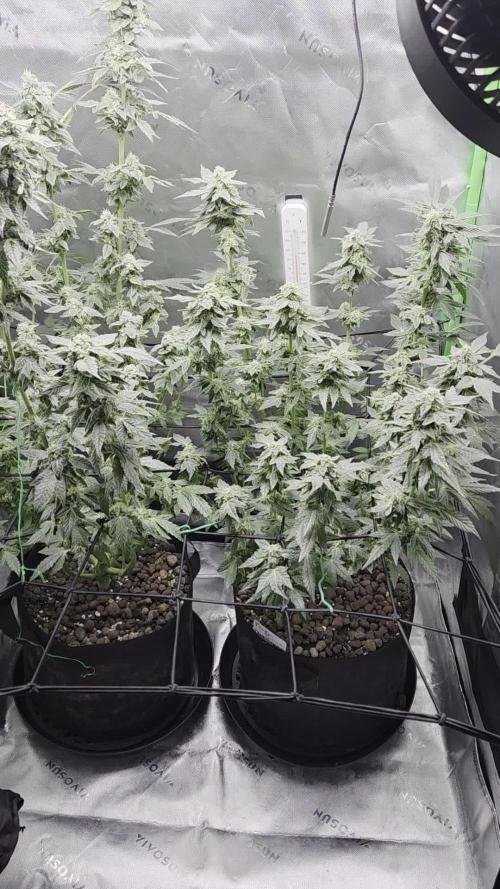The Grow Awards 2026 🏆 





































Likes
Comments
Share


@farah4weed
Follow
I used overdrive fertilizer again this week.
My God, girls get more beautiful like this.
The last weeks make me very happy.😍🌷💐💥⚘️👽👽🎍
From now on, I will be very careful because the more I improve the conditions, the better results I get
Especially the temperature difference between night and day.
humidity
Box ambient temperature
👊👊💧♠️
Likes
2
Share


@Jardineiro_Br
Follow
Comecei uma semana realizando o treinamento de baixo estresse e uma desfoliação. Não fiz poda top, não acho que seja adequado para plantas rápidas.
Vamos ver como vai ser o resultado. Não pretendo mais fazer intervenções no crescimento. A pequena lá do fundo não vou mexer .
Processing
Likes
9
Share


@JerMeds
Follow
Well the buds are stacking up pretty well. They have been trying to stretch a little this week so I have been LST branches as they pop up and trying to keep them from getting too close to the lights. Its a really tight fit so going forward I gotta be careful what strains I grow in this cabinet. I will have to get some small/short strains to grow in here and recommendations?
Likes
9
Share


@Bread_n_Buds
Follow
This is one of the strains that is doing very well in both the technical/free versions, we are talking about the Fruti Punch Automatic by Zamnesia.
Remember that we are growing a plant worked with the techniques indicated and another left to grow without pruning to preserve its speed; in the previous/next diary you will find the other plant of the same variety.
In this diary we find a plant worked with a technique that I have recently become passionate about thanks to my friend Yan402 who in a discussion convinced me to study it further also on autoflowering plants, now I am having a lot of fun. This plant is eure being a medium low internode it has been worked with a very precise Main Lining, I have also done much better in terms of elegance but I like this one a lot too.
Comparison is the salt of experience, so the plant in the other diary will be treated very differently, go and see it to make a comparison.
We started the Plagron fertilization program, we are in 100% organic configuration, the soil is made up of recycled Promix + 1/3 fresh soil + 10% Perlite + RQS Mycorrhizae Mix (4 g in the mix, 1 g under the small fiber pot).
In the middle of the week the pre-flowering started so I decided to start the program for this phase: 1 ml/l of Power Roots - 1 ml/l of Pure Zym - 1 ml/l of Sugar Royal - 1 ml/l of Power Buds - 4 ml/l of Alga Bloom
Remember the Green Sensation from the 3rd/4th week of flowering depending on the flowering speed or how you see the calyxes composing, when the calyx is in the swelling phase it is used.
We sprayed 5 ml/l of Vita Race foliar fertilizer once a week.
-------------------------------------------------
https://plagron.com/it
We always have the excellent RQS mycorrhizae running through the soil.
https://www.zamnesia.io/it/5778-mix-micorrhiza-easy-roots.html
One of the best in recent years with a very high THC level
--------------------------------------------------------
https://www.zamnesia.io/en/10965-zamnesia-seeds-fruit-punch-automatic.html
Brief description of Zamnesia // Sativa strains are very rewarding to grow, but their long flowering times and their greater susceptibility to disease and overfertilization can make them a little more difficult to manage. Also, their imposing heights are less suitable for indoor use and can attract unwanted attention if grown outdoors. However, with the arrival of Fruit Punch Automatic, growing sativa strains at home just got a whole lot easier. Combining Skunk #1, Haze and ruderalis, Fruit Punch Auto is 70% sativa dominant and produces up to 21% THC, along with a delicious blend of terpenes. Plus, it can be grown indoors, outdoors and in greenhouses. With their bright green hues, golden pistils and thick layer of resin, Fruit Punch Auto buds always have a great appeal. When you smoke her, you will be amazed by her flavours, aromas and effects! As the name suggests, Fruit Punch Automatic boasts delicious tropical aromas reminiscent of banana, pineapple, mango and citrus. When you open the jars you will feel like you are in a tropical cocktail bar on an exotic beach. Fruit Punch Auto will delight your palate with pungent fruity notes followed by light notes of Skunk and spice on the exhale. Within minutes of your first hit, this potent sativa will stimulate your mind, leaving you in an energetic and carefree state, ideal for morning or daytime sessions, as well as social settings or creative pursuits.
The whole world of growing and much more is on Zamnesia: just take a look at the site and you will find "all the best that nature has to offer" in various shapes and colors.
---------------
www.zamnesia.com
Likes
10
Share


@Boomdrawfyah
Follow
80 dias y han empezado a florecer la mas avanzada es la 1051 que es la variedad con mas predominancia indica.
He empezado la primera semana de floracion con la tabla de elicitación y nutrición de terranabis, subiendole 0.2 ml de Terrateina y terra vigor , vamos a ver como responden
Likes
17
Share


@Sativa_Juice_Grows
Follow
Nov/21
She grew like crazy.
Big green fan leaves coming in.
Branches are growing strong.
Smell is starting to get intoxicating.
i finally got over my habit of nervous watering
and am feeding the girls way less and they're happy.
Cant wait to flip this girl to flower.
No problems this week at all.
11/29
Shes growing ok. Green and healthy branches and leaves.
She growing more like a sativa, sativa hybrid
tall and branchy, manageable fan leaves
but because of that she started to get some light burn.
Dont have my tent yet so i cant adjust my light any higher so i tried
to lower the plant down a little
So hoping she can do without super direct light for another day or so.
Other than that shes looking healthy.
(some of this is the same as White Widow diary)
11/30
It wouldn't let me do veg and flower in the same week
on the diary so i just split it up in here.
Two busy days.
Tent came i!! which im super excited about
because now i flip the girls to flower.
It wouldnt let me do veg and flower in the same week
on the diary so i just split it up in here.
I spent tuesday putting the tent together
and dropped a video of the new setup because
im REALLY excited about.
got the ladies nice and cozy. Started them on 12/12.
Its my first time on an indoor grow so i hope it works out well
Shes super healthy. Super green leaves are big
stems are thick
everything is a lovely dark green
i can smell it more because theyre tented now.
but it looks great.
12/1
topped dressed with some happy frog soil
I couldnt add the castings amount in the thing above
So ill say i mixed about a quarter of the amount of soil
into about 1 to 2 gallons of top soil
i had some down to earth
dry amendments i mixed in with that soil as well.
i couldnt tell how much soil exactly.
I only put in 5 tsp of great white instead of the recommended 7
because i switched the bloom nutes and i didnt wanna over do it
i couldnt tell how much soil exactly.
Fed them some flowering nutes, but cut back
on the amount of nutes by a lot.
Decided im going to just follow what biobizz instructions
say from now on so apparently less is better.
started the bloom and the top max kept everything else the same
and cut out the fish mix for flower, added great white at the end.
Defoliated the bottom few branches and cleaned any growth at wasnt going to produce.
Nothing to major.
12/2
Temp of tent is steady at 70, 71 degrees.
thats a little bit lower than id like but ill
figure out something in the next few days.
Took the bottom branches and leaves the night before and
Wanted to give it a night of rest before i defoliated the big leaves.
Took most of them off but left the few at the top of the plant.
Looking extremely green. Hoping i get to see some pistils soon.
Likes
5
Share


@Krissci
Follow
Didn't realize I didn't start a diary for this.
Very lazy...
Overall plant seems happy..
This week and going forward mostly LST and light fan leaf defoliation.
Likes
7
Share


@DrewbieDoobieNoobie
Follow
These were all pretty Uniform in height and weight even with #3 being replanted 2 weeks in, lots of Haze smell diesel and pungent on the front end and some sweet at the tail, I should of let these go a few more weeks I think it would be better. I have read and have heard that the flowering time the breeders recommend is based on a 1000w set up. and light plays an important roll in yield as far as flowering goes Its all about time. and maybe next time I will grow these to a more perfect pant. but this round as a grower I give myself a 6 out of 10 got some buds to some and turned the trim and larf to hash, not a huge return and the Trichomes were mainly in the 25 micron range with a minimal amount in the 76 micron bag. so My thinking is that these were all small and under developed trichomes, this leans into my theory that they could have gone another 3 or for weeks, Failure has been my greatest teacher and I really enjoy this hobby. Next grow will be an Organic Dry Amendment Auto Flower with new lights no more Blurple import lights. I got my 1st vaccine shot. hope you all are staying safe and lifted.
BDH#1 13 oz wet
42gm buds
30gm larffy trim
BDH#2 13 oz wet
26gm buds
42gm larffy trim
BDH#3 13oz wet
20gm buds
42gm larffy trim
TOTAL 39oz wet
TOTAL 94 gm buds 97gm larffy buds
Likes
100
Share


@m0use
Follow
The crisping of the leaves where bothering me so I decided to do a hard flush of the plants to lower what I think was a EC issue. I was also wondering about the PH and it was on point at 6.8 from the flush water I gathered. I do not own a EC pen so could not monitor that aspect of it. It looks like it may have helped a bit. Hard to tell at this point the death has slowed a lot and I am seeing fading signs that I am used to seeing so it makes me feel a bit better. I think I have stunted this growth a bit because of this mishap but should still be a good harvest.
The soils temp is getting down to 12c at night, The ambient air temps of the tent are aorund 15-18 at night though. Good for adding colour into the fade.
During the say its keep steady around 26-27.
Starting to smell more and more and loving every time I open the tent. Given they are stuck in a scrog net trying to remove the bottom trays to empty them cause them to be rustled a bit and they released a lot of lovely scents. I am in the last week or two now. Will be giving them one more heavy molasses feeding and then nothing else. They got their last ChitoSal and I think it made a difference, would really need a side by side to confirm if its working at all.
Will monitor its length from the SCROG net vs soil as its easier to measure.
33cm from SCROG net to base of plant
18cm from SCROG net to tip of plant
Total 51cm for week eight of flower. +0.5cm from Last Week
Just like last week I am no longer posting about the clones in this diary. Maybe give them a recap blurb in the harvest entry.
Likes
57
Share


@PEAKYPLANTERS
Follow
Hi everyone, Weed brothers.
Here we are ready for a new week of fire!
My dolls have been transferred under a wider tent with the hope of opening up their final yield ....
It's very hot ... let's get the best
Likes
14
Share


@JuanHaze_Arg
Follow
Los Últimos días de vida de la planta ya casi no la regaba, por falta de tiempo y para no generar humedad ambiente, días lluviosos con cortes de luz nos jugaron una mala pasada por eso se decide cosechar, las flores se ven hermosas de colores morados con verdes y amarillos de las hojas más viejas. Un cultivo sin estrés, aplicando productos nuevos y viendo muy buenos resultados. La única decisión mal tomada fue haber lavado raíces tan temprano, podría haber ganado algo más de peso con el monster bloom
Likes
62
Share


@MeaCulpa
Follow
I got my humidity under control.
From now on there is only H2O without fertilizer.
But I think my gorilla is a little too brown. I really hope it has to be that way.
Otherwise all the other ladies are looking great.
Likes
9
Share


@Xabii
Follow
Values are average of the day.
DATE - °C - RH% (Tent Temp/RH)
20240627 27.6 52.4
20240628 24.2 50.6
20240629 26.0 47.1
20240630 25.7 55.9
20240701 23.8 54.4
20240702 22.1 58.0
20240703 21.7 57.4
DATE - PH
20240627 #
20240628 5.55
20240629 5.40
20240630 6.27
20240701 5.82
20240702 5.91
20240703 6.19
DATE - EC(us/cm)
20240627 #
20240628 633
20240629 663
20240630 1095
20240701 1033
20240702 997
20240703 950
DATE - °C (Reservoir)
20240627 #
20240628 23.7
20240629 23.3
20240630 24.1
20240701 22.2
20240702 20.5
20240703 20.1
Likes
16
Share


@SeshHouseCannabis
Follow
Have some problem with unfiltered water and it just cause the water to be come unclean and the root seem to also be uncleaned and unhealthy.
Likes
2
Share


@Davesflavours
Follow
Can't complain with another good week!
More pistils are starting to turn orange and buds are looking good and healthy, I've got no burnt tips and so im guessing the nutrient mix is balance nicely after removing the silica after it kept reacting with the mix.
Done another defoliation to get that light where it's needed, im very happy with these two plants as they are only my 2nd and 3rd plants I've ever grown.
Thanks for stopping by✌️
Likes
19
Share


@MrGrowMan
Follow
week 20-21
1 nutrient water
1 non nutrient water
LsT and Scrog
Diesel and Mimosa Harvest
day 62 start 12/12 light period (genetically damaged plants)
2 break up cake day 67 start flowering
17.03 day 130 Left flush.
21.03 day 134 Right Flush.
Likes
18
Share


@BudMunchies
Follow
10/01: They are growing fine and seem happy. I plan to swap out the water, defoliate and switch the lights to 12/12 this weekend. I will be removing an hour of light each day leading up until the weekend.
Processing
Likes
25
Share


@Cannibalgardens
Follow
Well they are all set and into the forever homes all put into promix soil with added root stimulant ..They are all happy and healthy going to be adding a netting and doing it that way .. These are all maxing breeders with great genetics .. The beast is going to be the @sweetseeds #sanfernandolemonhush she is leaning hard on the sativa side with long branching allready mm can't wait to see how they do in two weeks time ..
Likes
10
Share


@HideAndFly420
Follow
First week is goin really rapid, blue dream is growng large and healthy.
i didn t add any radicant or nutrients i just use all mix soil that give all i need to first period.
Let's go!




























